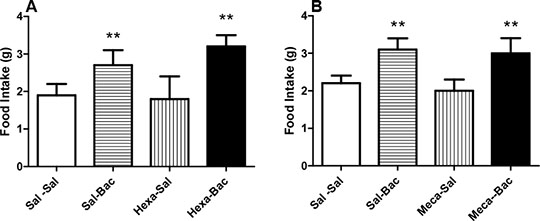Effects of hexamethonium and mecamylamine on baclofen-induced hyperphagia in non-deprived rats We have previously demonstrated that systemic administration of the GABAB receptor agonist baclofen (bac) increases food intake in non-deprived rats by a central mechanism of action (see Ebenezer et al., 2004). As part of a continuing programme to investigate possible interactions of bac with central neurotransmitter / neuromodulator systems on ingestive behaviour, the present study was undertaken to examine the effects of the peripherally and centrally active nicotinic acetylcholine (ACh) receptor antagonists hexamethonium (hexa) and mecamylamine (meca) respectively on bac-induced hyperphagia. Experiment 1: Male Wistar rats (n = 8; body weight: 375 – 455 g) were injected i.p. with either saline (sal) followed 15 min later by sal, sal followed by bac (2 mg kg-1), hexa (2 mg kg-1) followed by sal, or hexa (2 mg kg-1) followed by bac (2 mg kg-1). Immediately after the 2nd injection the rats were placed singly in separate experimental cages with free access to food and water. Cumulative food intake was measured as described previously (Ebenezer et al., 2004). A repeated measures design was used with each rat receiving all treatments; 2 – 4 days separated successive trials. Experiment 2: A similar protocol as described for Experiment 1 was used, except that the male Wistar rats (n=8, body weight: 350 – 450 g) were injected i.p. with meca (2 mg kg-1) instead of hexa. The data was analysed by two way ANOVA and the post-hoc Student-Newman Kuel’s test.

Fig 1. Effects of pretreatment with (A) hexamethonium and (B) mecamylamine on baclofen-induced hyperphagia. Vertical lines rep. + s.e. mean **P<0.01 vs Sal-Sal The results for cumulative food intake at 30 min are shown in Fig. 1. Bac significantly increased food intake (P<0.01) in both experiments. Hexa (Expt. 1) and meca (2 mg kg-1) (Expt. 2) had no significant effect on food intake compared with control data. ANOVA revealed that there was no significant interaction between the treatments for both experiments indicating the hyperphagic effect of bac was not significantly reversed by pre-treatment with either hexa or meca. A 2 mg kg-1 dose of these antagonists was considered appropriate for use in this study as it has been shown that this dose of meca significantly attenuates the hyperphagia elicited by the orexigenic peptide ghrelin in non-deprived rats (Dickson et al., 2010). The results of this study therefore indicate that it is unlikely that bac interacts with either a peripheral or central nicotinic ACh system to elicit its hyperphagic effects. Dickson, S.L. et al. (2010) Neuroscience, 171, 1180 – 1186. Ebenezer, I.S. et al. (2004). Meths. Find. Expt. Clin. Pharmacol. 26, 627 – 630. The study was supported by the European Union InterReg TransChannel Neuroscience Network.
|


